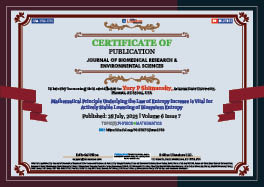2025 July 28;6(7):984-985. doi: 10.37871/jbres2153.
Bridging Physics and Mathematics: Why Their Synergy Shapes the Future of Science
Jessie Evans*
Physics and mathematics have been inseparable partners for centuries, forming the foundation of scientific discovery. Mathematics provides the precise language to describe theories, while physics offers the real-world phenomena that inspire mathematical breakthroughs. In today’s fast-paced research environment, their interdependence is more crucial than ever.
Mathematics: The Language of Nature
Galileo once observed that “The book of nature is written in the language of mathematics.” This insight remains true in the 21st century. From Newton’s laws of motion to quantum mechanics, every major advance in physics has relied on mathematical formulation.
Equations are not just numbers—they reveal deep symmetries and patterns in the universe. For example, differential equations underpin models of planetary motion, while probability theory helps describe the behavior of particles in quantum physics.
Learn more about Physics at JBRES:
https://www.jelsciences.com/topics/138/physics
Physics: The Playground for Mathematical Ideas
While mathematics provides the tools, physics often drives innovation. Entire branches of mathematics—such as non-Euclidean geometry, complex analysis, and tensor calculus—gained importance when applied to physical theories.
Einstein’s general relativity would have been impossible without the mathematical framework of Riemannian geometry. Similarly, the wave function in quantum mechanics is grounded in complex number theory and linear algebra.
Explore Mathematics and Applied Sciences at JBRES:
https://www.jelsciences.com/topics/146/mathematics
The Modern Frontier
Today, challenges such as dark matter, quantum gravity, and the unification of forces require even deeper integration of mathematics and physics. The Standard Model of particle physics depends on advanced algebraic structures, while cosmology relies on statistical methods to interpret data from the cosmic microwave background.
Challenges and Opportunities
However, a gap often exists between highly abstract mathematics and experimental physics. Closing this gap requires:
- Interdisciplinary training for young researchers.
- Collaboration between mathematicians and physicists in shared research environments.
- Encouragement of mathematical creativity driven by experimental results.
A Call for Integration
The future of science depends on blending these disciplines. Physics without mathematics risks losing precision; mathematics without physics risks losing purpose. With AI-driven simulations, quantum experiments, and space-based telescopes, collaboration between these fields will shape the next era of discovery.
Every equation tells a story. Every physical law is a chapter in the grand narrative of the universe. The synergy between physics and mathematics is not optional—it is essential for humanity’s next leap forward.
Submit your own Physics or Mathematics article to JBRES:
https://www.jelsciences.com/submit-your-paper.php
Content Alerts
SignUp to our
Content alerts.
 This work is licensed under a Creative Commons Attribution 4.0 International License.
This work is licensed under a Creative Commons Attribution 4.0 International License.








